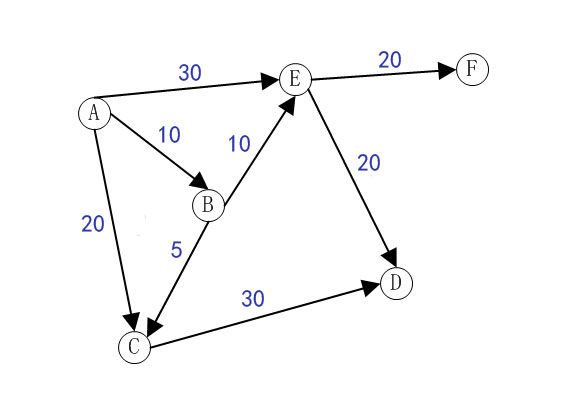首先新建一个网图如下:

图的表示法有好多中,最常用的应该是邻接矩阵与邻接表。上面的图,边很少,用邻接表来表示就很不错。
对于以上图,可以对象出3个类。图、节点、边。3个实体类代码如下:
边Edge:
public class Edge { public string StartNodeID { get; set; } public string EndNodeID { get; set; } public int Weight { get; set; } }
节点Node:
public class Node { private string id; private IList<Edge> edgeList; public Node(string nid) { id = nid; edgeList = new List<Edge>(); } public string Id { get { return id; } } public IList<Edge> EdgeList { get { return edgeList; } } }
图Graph:
public class Graph { public List<Node> NodeList = new List<Node>(); }
由于要求的就是最短路径,路径对象模拟如下:
public class Path { public string CurrentNodeId; public bool IsProcessed = false; public int Weight = 99999999; public List<string> PathNodeList = new List<string>(); }
最短路径计算类:
/// <summary> /// 计算最短路径帮助类 /// </summary> public class CaculateHelper { private Dictionary<string, Path> dicPath = new Dictionary<string, Path>(); public Dictionary<string, Path> DicPath { get { return dicPath; } } public void IniFirstNode(Graph graph, string StartNodeId) { Node OriginNode = null; foreach (Node node in graph.NodeList) { if (node.Id == StartNodeId) { OriginNode = node; } else { Path path = new Path(); path.CurrentNodeId = node.Id; dicPath.Add(path.CurrentNodeId, path); //初始化A->到所有边都是默认的Path 99999999 } } //如果有A直接进入的边,则设置为相应权重值,和记录下路径 foreach (Edge edge in OriginNode.EdgeList) { Path path = new Path(); path.CurrentNodeId = edge.EndNodeID; path.Weight = edge.Weight; path.PathNodeList.Add(edge.StartNodeID); dicPath[path.CurrentNodeId] = path; } } public Node GetFromNodeMinWeightNode(Graph graph) { Node CNode = null; KeyValuePair<string, Path> KVPPath = dicPath.Where(m => !m.Value.IsProcessed).OrderBy(m => m.Value.Weight).FirstOrDefault(); if (KVPPath.Key != null) { CNode = graph.NodeList.FirstOrDefault(m => m.Id == KVPPath.Value.CurrentNodeId); } return CNode; } /// <summary> /// 计算最短权值路径 /// </summary> public void CatelateMinWeightRoad(Graph graph) { //取从第一个点出发,最小权值且未被访问果的节点的点 Node CNode = GetFromNodeMinWeightNode(graph); //这段代码是核心 循环每个顶点,看看经过该顶点是否会让权值变小,如果会则存起此路径。直到再未访问过的点 while (CNode != null) { Path CurrentPath = dicPath[CNode.Id]; foreach (Edge edge in CNode.EdgeList) { Path TargetPath = dicPath[edge.EndNodeID]; int tempWeight = CurrentPath.Weight + edge.Weight; if (tempWeight < TargetPath.Weight) { TargetPath.Weight = tempWeight; TargetPath.PathNodeList.Clear(); for (int i = 0; i < CurrentPath.PathNodeList.Count; i++) { TargetPath.PathNodeList.Add(CurrentPath.PathNodeList[i].ToString()); } TargetPath.PathNodeList.Add(CNode.Id); } } //标志为已处理 dicPath[CNode.Id].IsProcessed = true; //再次获取权值最小的点 CNode = GetFromNodeMinWeightNode(graph); } } }
主控制台程序:
class Program { static void Main(string[] args) { Graph graph = new Graph(); #region 初始化一个图的 节点和边 //***************** B Node ******************* Node aNode = new Node("A"); graph.NodeList.Add(aNode); //A -> B Edge aEdge1 = new Edge(); aEdge1.StartNodeID = aNode.Id; aEdge1.EndNodeID = "B"; aEdge1.Weight = 10; aNode.EdgeList.Add(aEdge1); //A -> C Edge aEdge2 = new Edge(); aEdge2.StartNodeID = aNode.Id; aEdge2.EndNodeID = "C"; aEdge2.Weight = 20; aNode.EdgeList.Add(aEdge2); //A -> E Edge aEdge3 = new Edge(); aEdge3.StartNodeID = aNode.Id; aEdge3.EndNodeID = "E"; aEdge3.Weight = 30; aNode.EdgeList.Add(aEdge3); //***************** B Node ******************* Node bNode = new Node("B"); graph.NodeList.Add(bNode); //B -> C Edge bEdge1 = new Edge(); bEdge1.StartNodeID = bNode.Id; bEdge1.EndNodeID = "C"; bEdge1.Weight = 5; bNode.EdgeList.Add(bEdge1); //B -> E Edge bEdge2 = new Edge(); bEdge2.StartNodeID = bNode.Id; bEdge2.EndNodeID = "E"; bEdge2.Weight = 10; bNode.EdgeList.Add(bEdge2); //***************** C Node ******************* Node cNode = new Node("C"); graph.NodeList.Add(cNode); //C -> D Edge cEdge1 = new Edge(); cEdge1.StartNodeID = cNode.Id; cEdge1.EndNodeID = "D"; cEdge1.Weight = 30; cNode.EdgeList.Add(cEdge1); //***************** D Node ******************* Node dNode = new Node("D"); graph.NodeList.Add(dNode); //***************** C Node ******************* Node eNode = new Node("E"); graph.NodeList.Add(eNode); //E -> D Edge eEdge1 = new Edge(); eEdge1.StartNodeID = eNode.Id; eEdge1.EndNodeID = "D"; eEdge1.Weight = 20; eNode.EdgeList.Add(eEdge1); //E -> F Edge eEdge2 = new Edge(); eEdge2.StartNodeID = eNode.Id; eEdge2.EndNodeID = "F"; eEdge2.Weight = 20; eNode.EdgeList.Add(eEdge2); //***************** F Node ******************* Node fNode = new Node("F"); graph.NodeList.Add(fNode); #endregion //计算从A -> C的最短权值路线 string StartNodeId = "A"; string EndNodeId = "F"; CaculateHelper CH = new CaculateHelper(); //第一步,初始化初始化源点 A 到 其他各点的 权重以及 路径(完成 A->B A->C A->E A->D 边权重,与A无直接边的则默认99999999) CH.IniFirstNode(graph, StartNodeId); //第二步,从权重最小的点开始,一直到权值最大的点 CH.CatelateMinWeightRoad(graph); #region 以下与计算无关,仅仅用于将结果打印出来 Path ShowPath = CH.DicPath[EndNodeId]; foreach(string MiddleNodeId in ShowPath.PathNodeList) { Console.WriteLine(MiddleNodeId); } Console.WriteLine(ShowPath.Weight); #endregion Console.ReadKey(); } }
不要小看上面这几行代码,哥看了好久才看懂,如果Node里加几个坐标,就能在地图上面展示了。下一篇会将它改造成可以在地图上面展示的路径规划。